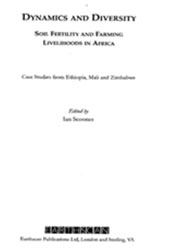{jathumbnail off} Local classification of soil types,
Local classification of soil types,
Gororo, southern Chivi Views on inorganic fertilizers and manures from Chivi communal Area Wetlands and gardening Profdes of case study farmers according to four soil-fertilitychange scenarios experimenting farmers in Chivi communal area Rural livelihoods: identifying avenues for intervention forsoil-fertility management Identifying options for policy and practice: examples from the field sites.
The reasons for the very significant gap between potential and realized food production in sub-Saharan Africa are multiple and complex. The decline in fertility observed for many areas of soil has been described as the single most important factor. Although this is a challengeable statement it undoubtedly refers to an ever-present reality for the majority of farmers in the continent – that optimizing the nutrient balance on their farms is one of the most difficult of the many agricultural management challenges they face.
A central feature of this hook is the documentation of the great variety of ways in which farmers have dealt with this problem. More importantly it also gives excellent insight into the ways in which the soil fertility issue interacts with a multiplicity of other factors which impact on farm production – biological, economic, social and political. Scientists, with their strong disciplinary adherences, apply the power of reductive research to these issues and often provide solutions which are valid within their own limits, hut which are difficult to apply because of the lack of attention to these interactive factors.
The work reported in this book helps to resolve this disjunction between formal scientific method and the realities of farm management. Scientificmethods of varying degrees of formality are used to document and analyse the soil fertility ‘prohlem’, the factors which influence it and farmers’ coping strategies. The replication of this across different countries, environments and communities permits the drawing of commonalities as well as distinctions. The major benefit that may be gained from this is to inform scientists -not just with data hut with insights into the realities of the totality of the farming enterprise. The challenge is then to identify those ‘entry points’ where formal scientific knowledge can he employed to enhance the system as a whole.
A strong case can indeed be made that soil fertility management is a very significant entry point because of the many interactions it has with othercomponents and because of the long-term nature of the effects that result from changes in soil nutrient status. This book is thus to be recommended not just for the information and insights it provides with respect to the specific issue of soil fertility management, but also because of the major questions it provokes about the application of scientific research to the challenges of sustainable agriculture under the prevailing conditions in African countries.
